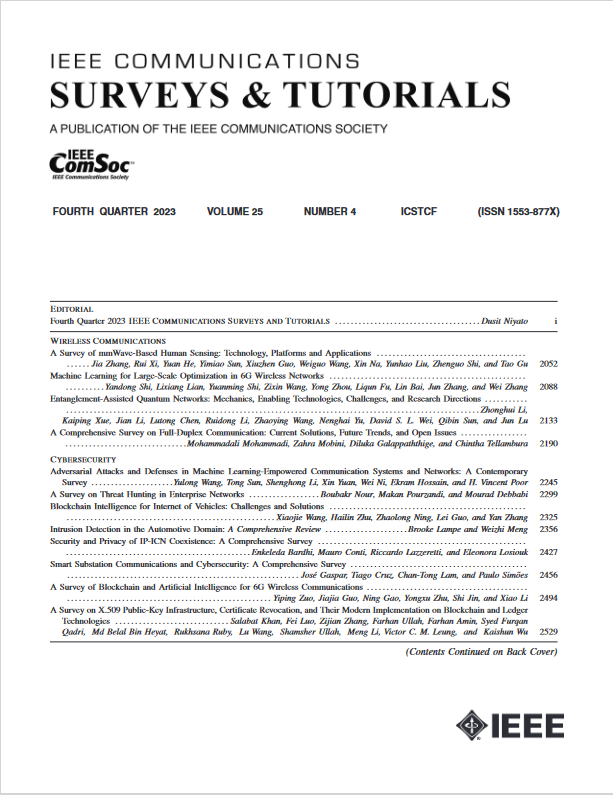Odor-Based Molecular Communications: State-of-the-Art, Vision, Challenges, and Frontier Directions
IF 34.4
1区 计算机科学
Q1 COMPUTER SCIENCE, INFORMATION SYSTEMS
引用次数: 0
Abstract
Humankind mimics the processes and strategies that nature has perfected and uses them as a model to address its problems. This has led to a new communication technology, molecular communication (MC), using molecules to encode, transmit, and receive information. Despite extensive research, an innate MC method found abundantly in nature-olfactory or odor communication-has not been thoroughly studied using information and communication technologies (ICT). Existing studies focus on digitizing this sense and developing actuators without examining odor-based information coding and MC principles, significantly limiting its application potential. Hence, cross-disciplinary research is needed to uncover the fundamentals of this unconventional communication modality from an ICT perspective. The ways of natural odor MC in nature need to be anatomized and engineered for end-to-end communication among humans and human-made things to enable several multi-sense augmented reality technologies reinforced with olfactory senses for novel applications and solutions in the Internet of Everything (IoE). This paper introduces odor-based molecular communication (OMC) and thoroughly examines olfactory systems, exploring odor communication in nature, including odor information, channels, reception, spatial perception, and cognitive functions. Additionally, a comprehensive comparison of various communication systems sets the foundation for further investigation. By highlighting OMC’s unique characteristics, advantages, and potential applications, this paper lays the groundwork for modeling end-to-end OMC channels, designing OMC transmitters and receivers, and developing innovative OMC techniques.基于气味的分子通讯:技术现状、愿景、挑战和前沿方向
人类模仿大自然完善的过程和策略,并将其作为解决问题的模式。这导致了一种新的通信技术,分子通信(MC),利用分子来编码、传输和接收信息。尽管进行了广泛的研究,但在自然界中发现的一种先天MC方法-嗅觉或气味交流-尚未利用信息和通信技术(ICT)进行深入研究。现有的研究主要集中在将这种感觉数字化和开发执行器上,而没有研究基于气味的信息编码和MC原理,这大大限制了其应用潜力。因此,需要跨学科的研究来从ICT的角度揭示这种非传统通信方式的基础。自然界中自然气味MC的方式需要被解剖学和工程化,以实现人类和人造物之间的端到端通信,从而使几种以嗅觉增强的多感官增强现实技术在万物互联(IoE)中获得新的应用和解决方案。本文介绍了基于气味的分子通信(OMC),并对嗅觉系统进行了深入的研究,探讨了自然界中的气味通信,包括气味信息、通道、接收、空间感知和认知功能。此外,对各种通信系统的全面比较为进一步研究奠定了基础。通过强调OMC的独特特点、优势和潜在应用,为端到端OMC信道建模、OMC发射机和接收机设计以及开发创新的OMC技术奠定了基础。
本文章由计算机程序翻译,如有差异,请以英文原文为准。
求助全文
约1分钟内获得全文
求助全文
来源期刊

IEEE Communications Surveys and Tutorials
COMPUTER SCIENCE, INFORMATION SYSTEMS-TELECOMMUNICATIONS
CiteScore
80.20
自引率
2.50%
发文量
84
审稿时长
6 months
期刊介绍:
IEEE Communications Surveys & Tutorials is an online journal published by the IEEE Communications Society for tutorials and surveys covering all aspects of the communications field. Telecommunications technology is progressing at a rapid pace, and the IEEE Communications Society is committed to providing researchers and other professionals the information and tools to stay abreast. IEEE Communications Surveys and Tutorials focuses on integrating and adding understanding to the existing literature on communications, putting results in context. Whether searching for in-depth information about a familiar area or an introduction into a new area, IEEE Communications Surveys & Tutorials aims to be the premier source of peer-reviewed, comprehensive tutorials and surveys, and pointers to further sources. IEEE Communications Surveys & Tutorials publishes only articles exclusively written for IEEE Communications Surveys & Tutorials and go through a rigorous review process before their publication in the quarterly issues.
A tutorial article in the IEEE Communications Surveys & Tutorials should be designed to help the reader to become familiar with and learn something specific about a chosen topic. In contrast, the term survey, as applied here, is defined to mean a survey of the literature. A survey article in IEEE Communications Surveys & Tutorials should provide a comprehensive review of developments in a selected area, covering its development from its inception to its current state and beyond, and illustrating its development through liberal citations from the literature. Both tutorials and surveys should be tutorial in nature and should be written in a style comprehensible to readers outside the specialty of the article.
 求助内容:
求助内容: 应助结果提醒方式:
应助结果提醒方式:


